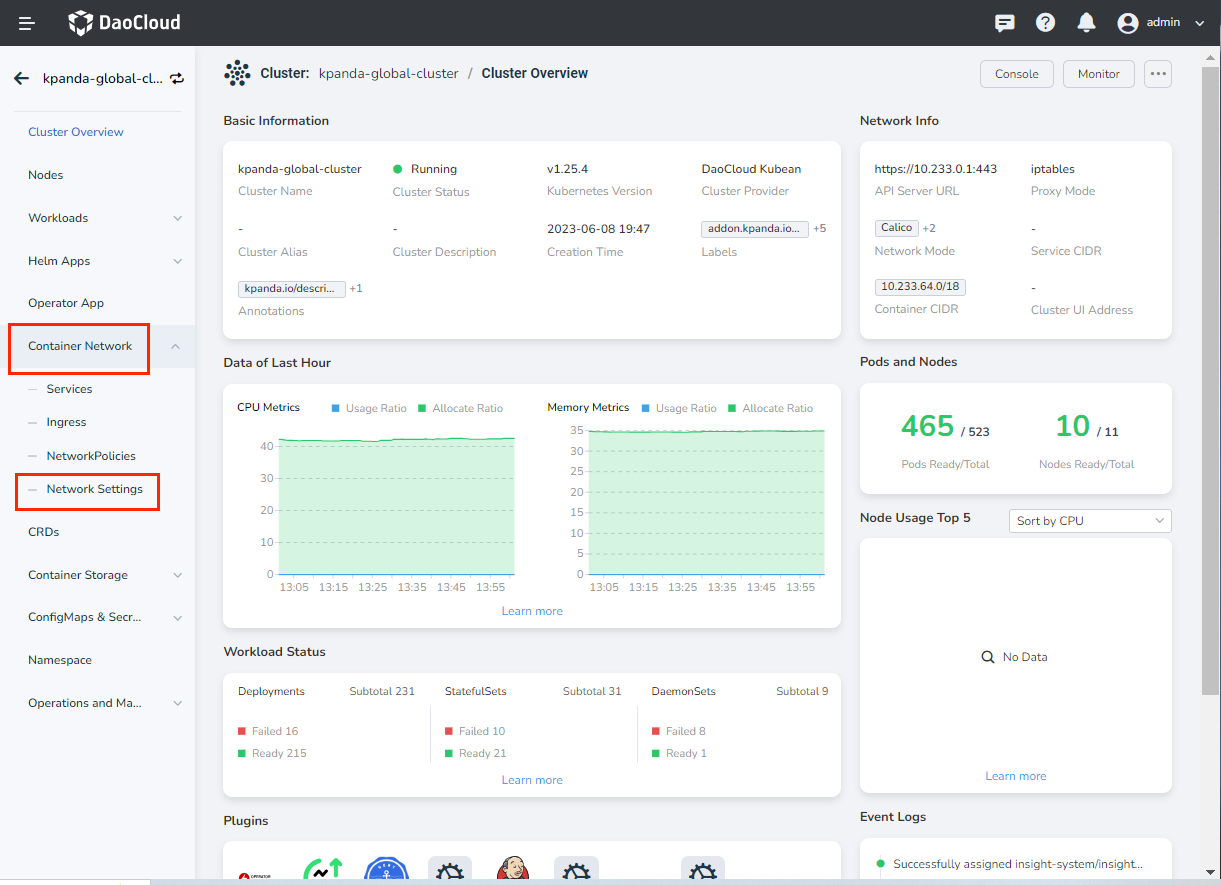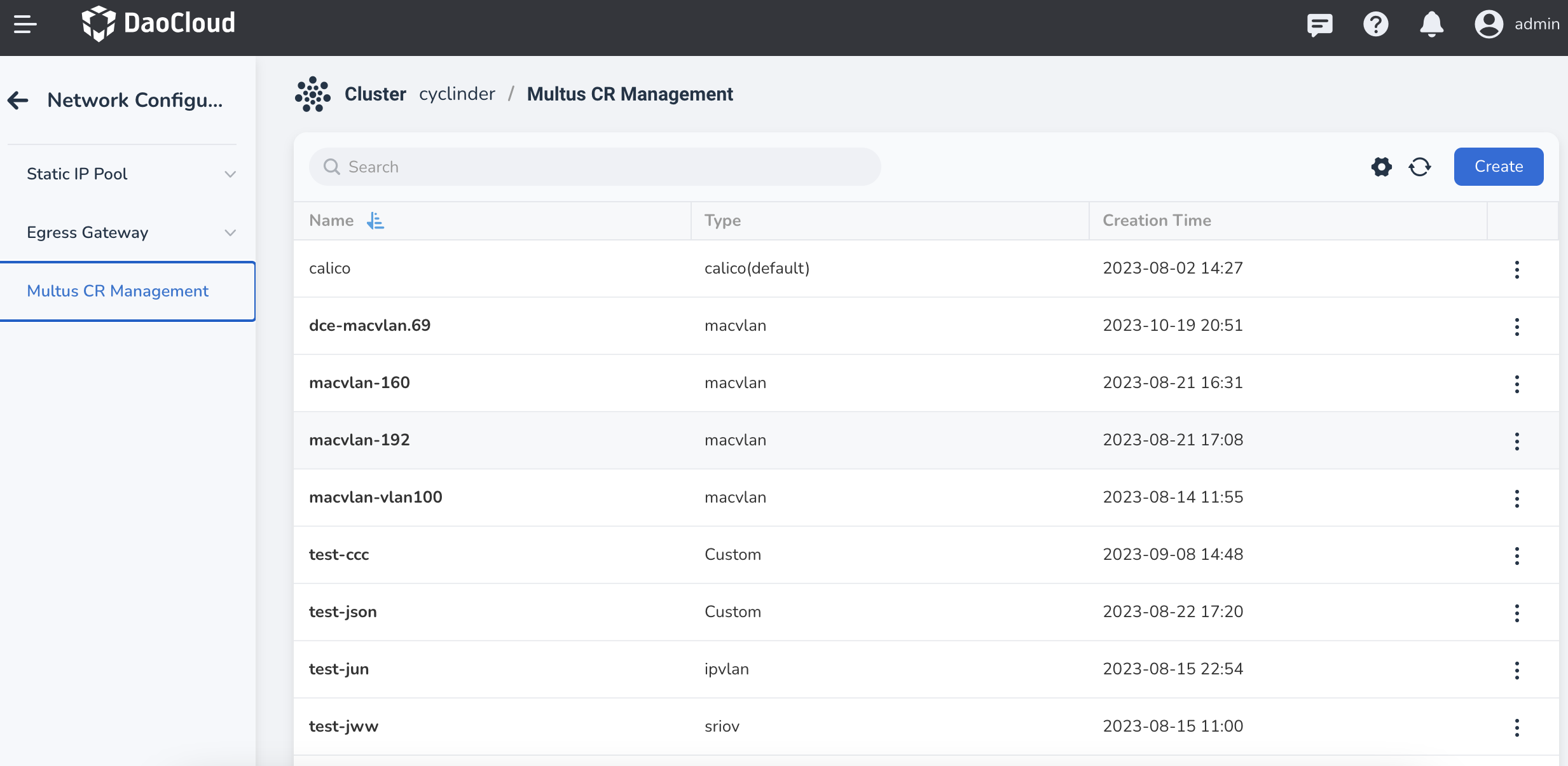Creating a Multus CR¶
Multus CR Management is the secondary encapsulation of configuration instances in Multus CNI by Spiderpool. It aims to provide more flexible network connectivity and configuration options for containers to meet different network requirements and provide users with a simpler and more cost-effective experience. This page explains how to create a Multus CR before using multiple NIC configurations for creating workloads. If you need to create a new Multus CR instance, you can refer to this document.
Prerequisite¶
SpiderPool has been successfully deployed since v0.8.7, which fully supports Multus-underlay.
UI Operations¶
-
After logging in to the DCE UI, click Container Management -> Clusters in the left navigation menu to find the proper cluster. Then click Container Network -> Network Settings on the left navigation menu.

-
Enter Network Settings -> Multus CR Management , and click Create Multus CR .

Note
When creating a Multus CR, the CNI shall be either macvlan, ipvlan, sriov, or custom. Three scenarios are available as below.
Create a Multus CR for macvlan or ipvlan¶
Enter the following parameters:

- Name : The instance name of the Multus CNI setting, which is the Multus CR name.
- Description : Description of the instance.
- CNI Type' : The type of CNI. Currently, you can choose between macvlan and ipvlan.
- Vlan ID : Only allowed to be configured when the CNI type is macvlan, ipvlan, or sriov. "0" and "" have the same effect.
- NIC Settings : It includes interface settings information.
- Please make sure that the primary NIC exists on the host.
- If you use the shared RDMA feature based on MacVlan/IPVlan, please make sure that the NIC has RDMA capability.
- When the number of NIC interfaces is one, there will only be one NIC interface in the default NIC configuration. When the number of added interfaces is greater than or equal to two, Bond-related setting can be done.
- NIC Interface : It is Only used for macvlan and ipvlan CNI types, and embraces at least one element. If there are two or more elements, Bond must not be empty.
-
Bond Information : The name cannot be empty, and the mode must be within the range [0,6], corresponding to the seven modes:
- balance-rr
- active-backup
- balance-xor
- broadcast
- 802.3ad
- balance-tlb
- balance-alb
-
IPv4 Default Pool: IPv4 default pool in the CNI configuration file. IPv6 Default Pool: IPv6 default pool in the CNI configuration file. Parameters are optional, and the input format isk1=v1;k2=v2;k3=v3, separated by;.
VLAN Configuration¶
- Underlay network refers to the underlying physical network, usually involving VLAN networks. If the Underlay network does not involve VLAN networks, there is no need to configure the VLAN ID(default value is 0).
- For VLAN subinterfaces:
- If the network administrator has already created the VLAN subinterfaces, there is no need to fill in the VLAN ID (default value is 0), just fill in the created VLAN subinterface in the Network Interface (Master) field.
- If automatic creation of VLAN subinterfaces is required, the VLAN ID needs to be configured, and the main network interface (Master) should be set to the proper parent interface. When creating a Pod, Spiderpool dynamically creates a subinterface named
<master>.<vlanID>on the host to connect the pod to the VLAN network.
- For Bond NIC:
- If the network administrator has already created the Bond NIC and is using it to connect the Underlay network of the pod, there is no need to fill in the VLAN ID (default value is 0), and just fill in the name of the created Bond NIC in the Network Interface (Master) field.
- If automatic creation of Bond NIC is required without creating VLAN subinterfaces, VLAN ID needs to be set to 0 and configured at least 2 network interfaces (Master) to form the Bond's Slave NICs. when creating a pod, Spiderpool dynamically creates a Bond NIC on the host to connect it to the Underlay network.
-
For RDMA NIC:
- If exposing the RoCE NIC on the host to the pod based on Macvlan/IPVLAN/SRIOV, the VLAN ID does not need to be filled in and defaults to 0.
-
Using Bond NIC to create VLAN subinterfaces:
- when the Bond NIC is created, VLAN subinterfaces needs to be created to accommodate the pod network at the same time, the VLAN ID needs to be configured. Spiderpool dynamically creates a VLAN subinterface named
<bondName>.<vlanID>on the host when creating a pod to connect it to the VLAN network. - All interfaces created through Spiderpool are not configured with IP addresses, and these interfaces are not persistent. If they are accidentally deleted or the node is restarted, these interfaces will be deleted, and they will be automatically re-created after restarting the pod. If persistence of these interfaces or configuration of IP addresses is required, consider using the nmcli tool.
- when the Bond NIC is created, VLAN subinterfaces needs to be created to accommodate the pod network at the same time, the VLAN ID needs to be configured. Spiderpool dynamically creates a VLAN subinterface named
Create a Multus CR for SR-IOV¶
Enter the following parameters:

- CNI Type : Select SR-IOV.
- VLAN ID : Must be filled in as
0. - RDMA : Not enabled by default. If you need to enable it, please meet the RDMA resource usage requirements.
- SR-IOV Resources : Only used for the
sriovtype, enter the resource name, which cannot be empty. Refer to SR-IOV CNI Configuration for how to view SR-IOV resources.
SR-IOV Resource Configuration Description:
SR-IOV resourceName is the custom name used when deploying sriovnetworknodepolicies.
If using SR-IOV with RDMA, the SR-IOV resource configuration can be queried as follows:
Command Query:
The spidernet.io/sriov_netdevice_enp4s0f0np0 below is the queried resource name.
kubectl get no -o json | jq -r '[.items[] | {name:.metadata.name, allocable:.status.allocatable}]'
[
{
"name": "10-20-1-220",
"allocable": {
"cpu": "56",
"ephemeral-storage": "3971227249029",
"hugepages-1Gi": "0",
"hugepages-2Mi": "0",
"memory": "131779740Ki",
"pods": "110",
"spidernet.io/hca_shared_devices": "0",
"spidernet.io/mellanoxrdma": "0",
"spidernet.io/sriov_netdevice": "0",
"spidernet.io/sriov_netdevice_enp4s0f0np0": "8", # 查询的 RDMA 设备资源名称及数量
...
}
}
GUI Query:
The queried resourceName needs to be prefixed with spidernet.io/.
Create a Custom Multus CR¶

- JSON : for custom types, make sure to input a valid JSON file.
After creating it, you can use the Multus CR to manage workloads.